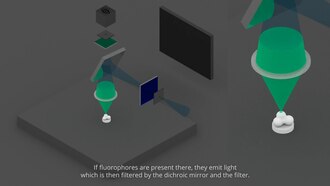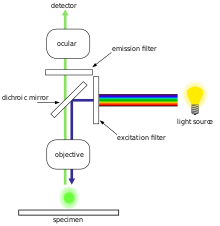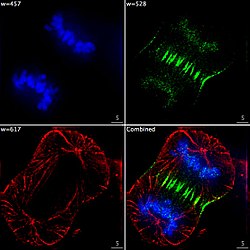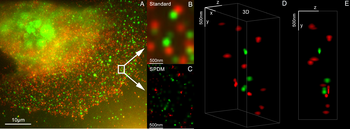An
upright fluorescence microscope (Olympus BX61) with the fluorescence
filter cube turret above the objective lenses, coupled with a digital
camera.
Fluorescence and confocal microscopes operating principle
A fluorescence microscope is an optical microscope that uses fluorescence and phosphorescence instead of, or in addition to, scattering, reflection, and attenuation or absorption, to study the properties of organic or inorganic substances.
"Fluorescence microscope" refers to any microscope that uses
fluorescence to generate an image, whether it is a more simple set up
like an epifluorescence microscope or a more complicated design such as a
confocal microscope, which uses optical sectioning to get better resolution of the fluorescence image.
Principle
The specimen is illuminated with light of a specific wavelength (or wavelengths) which is absorbed by the fluorophores,
causing them to emit light of longer wavelengths (i.e., of a different
color than the absorbed light). The illumination light is separated from
the much weaker emitted fluorescence through the use of a spectral
emission filter. Typical components of a fluorescence microscope are a
light source (xenon arc lamp or mercury-vapor lamp are common; more advanced forms are high-power LEDs and lasers), the excitation filter, the dichroic mirror (or dichroic beamsplitter), and the emission filter
(see figure below). The filters and the dichroic beamsplitter are
chosen to match the spectral excitation and emission characteristics of
the fluorophore used to label the specimen.
In this manner, the distribution of a single fluorophore (color) is
imaged at a time. Multi-color images of several types of fluorophores
must be composed by combining several single-color images.
Most fluorescence microscopes in use are epifluorescence
microscopes, where excitation of the fluorophore and detection of the
fluorescence are done through the same light path (i.e. through the
objective). These microscopes are widely used in biology and are the
basis for more advanced microscope designs, such as the confocal microscope and the total internal reflection fluorescence microscope (TIRF).
Epifluorescence microscopy
Schematic of a fluorescence microscope.
The majority of fluorescence microscopes, especially those used in the life sciences,
are of the epifluorescence design shown in the diagram. Light of the
excitation wavelength illuminates the specimen through the objective lens. The fluorescence
emitted by the specimen is focused to the detector by the same
objective that is used for the excitation which for greater resolution
will need objective lens with higher numerical aperture.
Since most of the excitation light is transmitted through the specimen,
only reflected excitatory light reaches the objective together with the
emitted light and the epifluorescence method therefore gives a high
signal-to-noise ratio. The dichroic beamsplitter acts as a wavelength
specific filter, transmitting fluoresced light through to the eyepiece
or detector, but reflecting any remaining excitation light back towards
the source.
Light sources
Fluorescence microscopy requires intense, near-monochromatic, illumination which some widespread light sources, like halogen lamps cannot provide. Four main types of light source are used, including xenon arc lamps or mercury-vapor lamps with an excitation filter, lasers, supercontinuum sources, and high-power LEDs. Lasers are most widely used for more complex fluorescence microscopy techniques like confocal microscopy and total internal reflection fluorescence microscopy while xenon lamps, and mercury lamps, and LEDs with a dichroic excitation filter are commonly used for widefield epifluorescence microscopes. By placing two microlens arrays into the illumination path of a widefield epifluorescence microscope, highly uniform illumination with a coefficient of variation of 1-2% can be achieved.
Sample preparation
A sample of herring sperm stained with SYBR green in a cuvette illuminated by blue light in an epifluorescence microscope. The SYBR green in the sample binds to the herring sperm DNA and, once bound, fluoresces giving off green light when illuminated by blue light.
In order for a sample to be suitable for fluorescence microscopy it
must be fluorescent. There are several methods of creating a fluorescent
sample; the main techniques are labelling with fluorescent stains or,
in the case of biological samples, expression of a fluorescent protein. Alternatively the intrinsic fluorescence of a sample (i.e., autofluorescence) can be used.
In the life sciences fluorescence microscopy is a powerful tool which
allows the specific and sensitive staining of a specimen in order to
detect the distribution of proteins
or other molecules of interest. As a result, there is a diverse range
of techniques for fluorescent staining of biological samples.
Biological fluorescent stains
Many
fluorescent stains have been designed for a range of biological
molecules. Some of these are small molecules which are intrinsically
fluorescent and bind a biological molecule of interest. Major examples
of these are nucleic acid stains such as DAPI and Hoechst (excited by UV wavelength light) and DRAQ5 and DRAQ7 (optimally excited by red light) which all bind the minor groove of DNA, thus labeling the nuclei
of cells. Others are drugs, toxins, or peptides which bind specific
cellular structures and have been derivatised with a fluorescent
reporter. A major example of this class of fluorescent stain is phalloidin, which is used to stain actin fibers in mammalian cells. A new peptide, known as the Collagen Hybridizing Peptide, can also be conjugated with fluorophores and used to stain denatured collagen fibers.
There are many fluorescent molecules called fluorophores or fluorochromes such as fluorescein, Alexa Fluors, or DyLight 488, which can be chemically linked to a different molecule which binds the target of interest within the sample.
Immunofluorescence
Immunofluorescence is a technique which uses the highly specific binding of an antibody to its antigen
in order to label specific proteins or other molecules within the cell.
A sample is treated with a primary antibody specific for the molecule
of interest. A fluorophore can be directly conjugated to the primary
antibody. Alternatively a secondary antibody,
conjugated to a fluorophore, which binds specifically to the first
antibody can be used. For example, a primary antibody raised in a mouse
which recognises tubulin combined with a secondary anti-mouse antibody derivatised with a fluorophore could be used to label microtubules in a cell.
Fluorescent proteins
The modern understanding of genetics
and the techniques available for modifying DNA allow scientists to
genetically modify proteins to also carry a fluorescent protein
reporter. In biological samples this allows a scientist to directly make
a protein of interest fluorescent. The protein location can then be
directly tracked, including in live cells.
Limitations
Fluorophores lose their ability to fluoresce as they are illuminated in a process called photobleaching.
Photobleaching occurs as the fluorescent molecules accumulate chemical
damage from the electrons excited during fluorescence. Photobleaching
can severely limit the time over which a sample can be observed by
fluorescence microscopy. Several techniques exist to reduce
photobleaching such as the use of more robust fluorophores, by
minimizing illumination, or by using photoprotective scavenger chemicals.
Fluorescence microscopy with fluorescent reporter proteins has
enabled analysis of live cells by fluorescence microscopy, however cells
are susceptible to phototoxicity, particularly with short wavelength
light. Furthermore, fluorescent molecules have a tendency to generate
reactive chemical species when under illumination which enhances the
phototoxic effect.
Unlike transmitted and reflected light microscopy techniques
fluorescence microscopy only allows observation of the specific
structures which have been labeled for fluorescence. For example,
observing a tissue sample prepared with a fluorescent DNA stain by
fluorescence microscopy only reveals the organization of the DNA within
the cells and reveals nothing else about the cell morphologies.
Sub-diffraction techniques
The wave nature of light limits the size of the spot to which light can be focused due to the diffraction limit. This limitation was described in the 19th century by Ernst Abbe
and "limits an optical microscope's resolution to approximately half of
the wavelength of the light used." Fluorescence microscopy is central
to many techniques which aim to reach past this limit by specialized
optical configurations.
Several improvements in microscopy techniques have been invented
in the 20th century and have resulted in increased resolution and
contrast to some extent. However they did not overcome the diffraction
limit. In 1978 first theoretical ideas have been developed to break this
barrier by using a 4Pi microscope as a confocal laser scanning
fluorescence microscope where the light is focused ideally from all
sides to a common focus which is used to scan the object by
'point-by-point' excitation combined with 'point-by-point' detection.
However, the first experimental demonstration of the 4pi microscope took place in 1994. 4Pi microscopy maximizes the amount of available focusing directions by using two opposing objective lenses or two-photon excitation microscopy using redshifted light and multi-photon excitation.
Integrated correlative microscopy
combines a fluorescence microscope with an electron microscope. This
allows one to visualize ultrastructure and contextual information with
the electron microscope while using the data from the fluorescence
microscope as a labelling tool.
The first technique to really achieve a sub-diffraction resolution was STED microscopy, proposed in 1994. This method and all techniques following the RESOLFT
concept rely on a strong non-linear interaction between light and
fluorescing molecules. The molecules are driven strongly between
distinguishable molecular states at each specific location, so that
finally light can be emitted at only a small fraction of space, hence an
increased resolution.
As well in the 1990s another super resolution microscopy method
based on wide field microscopy has been developed. Substantially
improved size resolution of cellular nanostructures
stained with a fluorescent marker was achieved by development of SPDM
localization microscopy and the structured laser illumination (spatially
modulated illumination, SMI). Combining the principle of SPDM with SMI resulted in the development of the Vertico SMI microscope. Single molecule detection of normal blinking fluorescent dyes like green fluorescent protein
(GFP) can be achieved by using a further development of SPDM the
so-called SPDMphymod technology which makes it possible to detect and
count two different fluorescent molecule types at the molecular level
(this technology is referred to as two-color localization microscopy or
2CLM).
Alternatively, the advent of photoactivated localization microscopy
could achieve similar results by relying on blinking or switching of
single molecules, where the fraction of fluorescing molecules is very
small at each time. This stochastic response of molecules on the applied
light corresponds also to a highly nonlinear interaction, leading to
subdiffraction resolution.
Fluorescence micrograph gallery
- Epifluorescent imaging of the three components in a dividing human cancer cell. DNA is stained blue, a protein called INCENP is green, and the microtubules are red. Each fluorophore is imaged separately using a different combination of excitation and emission filters, and the images are captured sequentially using a digital CCD camera, then overlaid to give a complete image.
- Human lymphocyte nucleus stained with DAPI with chromosome 13 (green) and 21 (red) centromere probes hybridized (Fluorescent in situ hybridization (FISH))
- Fluorescence microscopy of DNA Expression in the Human Wild-Type and P239S Mutant Palladin.














